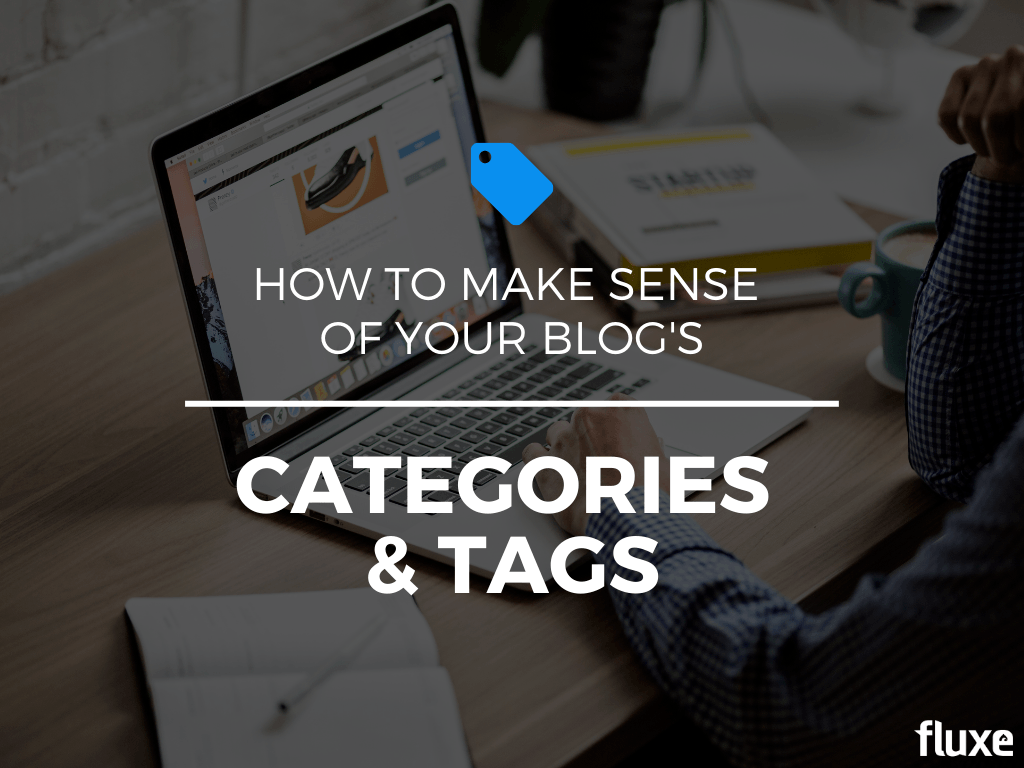When we start with a new content marketing client, we ensure a solid foundation to build upon, including an audit of their existing client.
How is it organized?
What are the categories?
What tags do they use?
This inventory makes projects easier, and Google responds to this organization by improving our client’s SEO.
Tags vs Categories
The next step is to ensure that everyone who touches the content understands that the words category and tag are not interchangeable. Categories are a way to broadly group similar pieces of content the way your customer can best find them. Tags are an internal tool to help you find and identify them.

What are Blog Categories?
Imagine your collection of blog posts as your main buckets or separate territories of content. What are the highest level or most thematic elements of the content?
HINT: If you’re a service-based business, your categories will usually align with the main services you offer. For example, some of our categories on the Fluxe blog are: Building Authority, Lead Generation & Content Marketing Strategy. If you find that posts are not aligning under the categories you’ve created to tell your story, it’s a good indication that your content creation is not following a strategic approach!
Categories are hierarchical, which means you can create subcategories if you have an enormous amount of content. But remember, in WordPress, you must choose at least one category per post.
Examples of Blog Categories:
To give you a better idea of how categories align with your services, I’ve listed a few different types of businesses and examples of blog categories for each.
- Business Coach: Marketing, Sales, Operations, Strategy, Team
- Property Management Company: Tenant Selection, Property Management, Property Maintenance, Rental Opportunities, Investor Resources
- Ear Nose & Throat Doctor: Ear, Nose, Throat (Pretty straightforward, right?)
- Recruiting Company: Hiring, Candidates, Company News, Market Insights
Category Best Practices
- Establish 3-5 main categories. Remember, you can drill down into subcategories if necessary.
- Limit blogs to one category per post. Adding multiple categories creates duplicate content of the category pages, and the overall effect is underdeveloped and thin.
- If a post can be categorized in multiple buckets, create an umbrella category to house all those identifiers.
- Don’t use the same name for a category AND a tag on your site. It isn’t apparent.
- Multiple categories do not have any SEO benefit. The rationale should be based on how it helps your visitors more easily find your content.
- If you want to create categories that rank for keywords, make cornerstone pages instead. They are designed around keywords so you can customize the call to action on a hub page.
What are Blog Tags?
Tags identify the posts so you can organize your content internally. They don’t help SEO, so there’s no reason to over-tag content with keywords. Again, if you aren’t thinking strategically about your content’s purpose, tags will not help at all. In fact, they lead to something called “tag bloat,” which is as unpleasant as it sounds. We once had a client who had over 5,000 tags!
If you’re wondering whether or not you should create a new tag, a good litmus test is asking yourself if there’s an actionable use for it now or in the future. If you can’t think of a way you’ll actually use the tag, don’t create it.
One of the best uses for tags is using them to help you identify content to repurpose in the future. They can help you spot trends or types of content that could be repurposed into things like products, books, series, email sequences, customer tutorials etc.
Examples of Blog Tags:
- The type of media: video, graphics, memes
- The location: physical and/or virtual
- The intent: news, anecdote, research, how-to, listicle
- The time of year: Holiday, Summer, Black Friday
- The product line: By use or solution
Tag Best Practices
- Stay consistent when you pluralize tags. Ensure that you don’t have multiples. (e.g., babies vs. baby)
- If it’s been a while since you’ve inventoried your tags, set aside time to clean them up. Only keep tags that will actually help you organize your content internally.
- Create an internal process for logging those tags. For example, if a post includes a video, tag it with “video”.
Organizing your content in well-demarcated categories will ultimately save you time and will help to solidify your message.
And…
When in doubt on whether you should add a tag or not, don’t do it.
Only you can prevent tag bloat.



